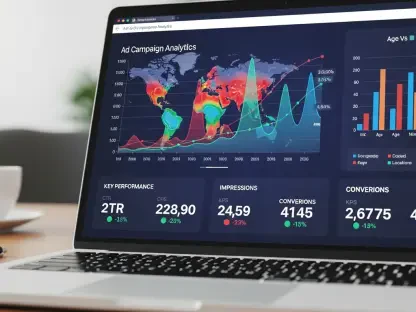In the ever-shifting landscape of digital marketing, a staggering statistic emerges: over 70% of marketers report that search engine algorithm changes have disrupted their content strategies in the past year alone, highlighting a critical challenge. This challenge lies in balancing the creation of high-volume content for immediate visibility with the development of high-authority, evergreen material for enduring trust. For businesses striving to maintain relevance in a competitive online space, mastering this equilibrium is no longer optional but essential. Artificial Intelligence (AI) stands as a transformative force in navigating this dilemma, offering tools to optimize both reach and credibility.
This guide aims to equip digital marketers and content creators with actionable strategies to harmonize SEO volume and authority using AI. It addresses the pressing need to adapt to sophisticated search engine priorities that value user experience above all. By following the outlined steps, readers will learn how to leverage AI to craft content that captures short-term traffic while building a lasting online presence, ensuring resilience amid constant algorithmic shifts.
The importance of this balance cannot be overstated in today’s digital environment, where search engines like Google prioritize depth and relevance through frameworks such as E-E-A-T (Experience, Expertise, Authoritativeness, Trustworthiness). Failing to integrate both volume and authority risks either fleeting visibility or missed opportunities for broad engagement. This guide serves as a roadmap to harnessing AI’s potential, providing clarity on aligning content strategies with user needs and search engine expectations for sustainable success.
The SEO DilemmVolume vs. Authority in the Age of AI
The core tension in modern SEO lies in choosing between producing a high volume of content to capture diverse search traffic and focusing on authoritative, evergreen pieces that establish long-term credibility. High-volume strategies often target trending topics and numerous keywords to maximize short-term reach, but they can dilute quality if not managed carefully. On the other hand, authority-driven content, such as in-depth guides, builds trust and attracts organic backlinks, though it requires significant time and resources to develop.
AI emerges as a pivotal solution to this conflict, offering capabilities to analyze data, predict trends, and automate processes at scale. With search engines continuously refining their algorithms to reward user value, the ability of AI to streamline content creation while maintaining high standards is a game-changer. This technology enables marketers to address immediate audience queries through frequent posts while simultaneously crafting cornerstone content that stands the test of time.
The relevance of this balance is amplified by the rapid evolution of digital tools and platforms. As AI-driven search features like overviews and summaries become more prominent, content must be structured to meet both immediate and enduring user needs. This section sets the foundation for exploring how a hybrid approach, powered by AI, can optimize visibility without compromising the depth required for sustained impact.
Why Balancing SEO Matters More Than Ever
The urgency of balancing SEO volume and authority stems from significant shifts in search engine priorities, particularly through updates like Google’s Helpful Content initiative. These changes emphasize content that genuinely serves users over sheer quantity, penalizing shallow, keyword-stuffed material. Marketers must now focus on delivering value, as algorithms increasingly measure engagement metrics like dwell time alongside traditional ranking factors.
Another driving factor is the rise of E-E-A-T principles, which have become a cornerstone of search engine evaluation. Content demonstrating expertise and trustworthiness gains preference in rankings, especially as AI platforms begin to favor authoritative sources for summaries and featured snippets. Industry reports underscore that failing to adhere to these standards can result in diminished visibility, particularly for brands relying solely on high-volume, low-depth tactics.
Insights from leading SEO analyses, such as those from Search Engine Land and LSEO’s annual reports, highlight the high stakes of adaptation. These sources note that businesses ignoring the shift toward quality risk losing ground to competitors who prioritize user-centric content. As the digital landscape grows more complex with AI integration, the need to strike a strategic balance becomes not just a competitive advantage but a survival imperative for online presence.
Crafting a Hybrid SEO Strategy with AI Tools
Step 1: Mapping Content to Audience Intent
The first step in achieving a balanced SEO strategy involves aligning content with audience intent using AI-powered tools. Understanding what users seek—whether quick answers or comprehensive insights—guides the creation of both high-volume posts for immediate queries and deeper, evergreen pieces for sustained engagement. AI platforms can dissect search data to reveal patterns, ensuring content addresses real needs rather than assumed interests.
Leveraging AI for Intent Analysis
AI tools excel at analyzing search trends and user behavior to uncover content gaps and high-opportunity topics. By processing vast amounts of data, these systems identify which questions users ask most frequently and which areas lack adequate coverage. This allows marketers to craft targeted, high-volume content for trending searches while planning authoritative resources to fill informational voids, enhancing overall relevance.
Building Content Funnels
A strategic content funnel is vital for guiding users from timely, high-volume articles to in-depth pillar content. This approach starts with broad, accessible posts that capture initial interest and then directs readers toward comprehensive guides or case studies that establish trust. Such a structure not only boosts immediate traffic but also fosters longer user sessions, signaling value to search engines and supporting ranking goals.
Step 2: Prioritizing Evergreen Authority with AI Insights
Creating evergreen content that stands as a reliable resource over time is the next critical step. AI can assist by providing data-driven insights to shape topics that resonate with core audience needs and industry trends. This content, often in the form of detailed reports or ultimate guides, becomes a foundation for building trust and attracting natural backlinks, key indicators of authority.
Incorporating Original Research
Original research and unique data significantly enhance content authority, aligning closely with E-E-A-T guidelines. AI tools can aggregate and analyze industry statistics to uncover fresh perspectives, enabling the creation of proprietary insights. Such material not only positions a brand as a thought leader but also increases the likelihood of citations and shares, amplifying long-term impact.
Optimizing for AI Overviews
Structuring content to appear in AI-generated overviews or summaries is another essential tactic. This involves using clear, concise language and organizing information with headers and lists that AI systems can easily parse. By optimizing for these features, evergreen content gains additional visibility, reinforcing credibility while reaching users who rely on quick, algorithm-curated answers.
Step 3: Scaling Volume Without Sacrificing Quality
Producing high-volume content efficiently while upholding quality standards is a challenge AI can address. Automation tools enable the rapid creation of relevant posts to capitalize on trends, ensuring a steady flow of material without overloading resources. This scalability helps maintain a consistent online presence, crucial for staying competitive in fast-paced search environments.
Automating Trend-Based Content
AI-driven content generation can quickly produce articles or social updates based on emerging trends or breaking news. These tools analyze real-time data to suggest topics and even draft initial content, saving time while ensuring relevance. However, human oversight remains necessary to add depth and avoid generic outputs that might trigger algorithmic penalties.
Implementing Technical SEO Boosts
Technical enhancements, such as schema markup and voice search optimization, support both volume and authority objectives. AI can identify areas for improvement, like structured data opportunities or conversational query alignment, to boost content discoverability. These tweaks ensure that even high-volume posts contribute to overall site credibility through better indexing and user accessibility.
Step 4: Adapting to Algorithm Shifts with Real-Time AI
The final step focuses on using AI for continuous content optimization amid unpredictable algorithm updates and search trends like zero-click results. Real-time analytics allow marketers to adjust strategies swiftly, ensuring content remains aligned with current search engine priorities. This adaptability is key to maintaining performance in a dynamic digital space.
Emphasizing People-First Planning
Prioritizing user value over mere metrics forms the bedrock of sustainable SEO. Industry conversations on platforms like X stress that content must solve real problems or answer genuine questions to retain relevance. AI can help by mapping content to user pain points, ensuring that both volume and authority efforts resonate with audience expectations above algorithmic gaming.
Monitoring Performance Metrics
AI systems excel at tracking key performance indicators such as dwell time, conversion rates, and citation frequency in real time. These metrics offer insights into how well content balances volume and authority, highlighting areas for refinement. Regular monitoring ensures that strategies evolve with user behavior and search engine updates, safeguarding long-term effectiveness.
Key Takeaways for a Balanced SEO Approach
- Utilize AI to align content with audience intent, seamlessly integrating volume with authority.
- Develop evergreen content as a cornerstone for sustained trust and organic traffic growth.
- Scale high-volume production through AI automation while preserving quality standards.
- Adapt to algorithm shifts using real-time AI optimization for ongoing relevance.
- Prioritize E-E-A-T principles to ensure content remains future-proof against evolving standards.
Future Trends: AI and SEO Beyond 2025
Looking ahead from 2025 to 2027, AI’s role in SEO is poised to deepen, with trends pointing toward an even greater emphasis on quality over quantity. Challenges such as zero-click searches, where users receive answers directly on result pages, will push marketers to focus on content that drives conversions rather than just impressions. This shift underscores the need for strategies that prioritize meaningful engagement over superficial metrics.
Industry projections from sources like Exploding Topics and Backlinko suggest that authority signals will dominate SEO landscapes by 2026. Content demonstrating deep expertise and trustworthiness will likely gain precedence in rankings and AI responses. Marketers must prepare by investing in robust, research-backed material that can withstand the test of time and algorithmic scrutiny.
The growing integration of AI in search technology also hints at more personalized and context-driven results. This evolution will demand content that not only addresses broad queries but also caters to niche, individualized needs. Staying ahead will require leveraging AI not just for creation but for predictive analysis, ensuring that strategies remain agile in an increasingly tailored digital ecosystem.
Final Thoughts: Building a Resilient SEO Future with AI
Reflecting on the journey through balancing SEO volume and authority, it becomes clear that AI has transformed the approach to content strategy. The steps taken—from mapping audience intent to adapting in real time—have laid a solid foundation for navigating the complexities of search engine demands. This hybrid model has proven effective in sustaining visibility while cementing credibility in a crowded online space.
Moving forward, the focus should shift to experimenting with emerging AI tools that enhance personalization and predictive content planning. Exploring integrations that refine user targeting or automate deeper technical SEO fixes could yield even greater efficiency. Staying attuned to user feedback and evolving metrics offers a path to refine these strategies further.
As a next step, consider piloting small-scale AI-driven campaigns to test new content formats or distribution channels. Analyzing their impact on both immediate traffic and long-term authority provides valuable lessons for scaling efforts. Embracing this iterative mindset ensures that digital presence remains robust, ready to tackle future challenges with confidence.









